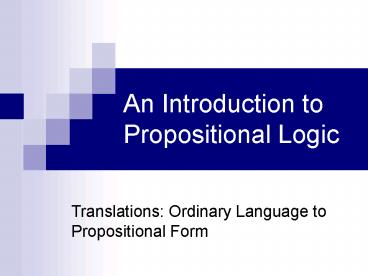An Introduction to Propositional Logic PowerPoint PPT Presentation
1 / 21
Title: An Introduction to Propositional Logic
1
An Introduction to Propositional Logic
Translations Ordinary Language to Propositional
Form
2
What is a Proposition?
- Propositions are the meanings of statements.
- I have no money
- Ich habe kein geld.
- Meanings are the thoughts, concepts, ideas we
are trying to convey through speech and writing.
3
Simple Propositions
- Fast foods tend to be unhealthy.
- Parakeets are colorful birds.
- (p. 290)
- Simple propositions are grammatically
independent expressions of information.
4
Compound Propositions
- If fast foods tend to be unhealthy, then you
shouldnt eat them. - Parakeets are colorful birds, and colorful birds
are good to have at home.
- People are free, if and only if they can choose
their actions and there are no forces compelling
those actions.
5
The Logic of Propositions
- To identify both simple and compound propositions
- To use this identification to
- Identify common patterns of thinking, and
- x
6
The Focus of Propositional Logic
- Propositional truth is determined by consulting
typical sources of information. - Propositional logic is determined by examining
how various propositions are related.
7
Types of relations between propositions
- 1 proposition is offered in support of another
(simple argument) - 1 proposition expressed the condition under which
a 2nd proposition is true (conditional statement) - 1 sentence offers two proposed alternatives, and
a 2nd proposition negates one of these
alternatives (disjunctive syllogism)
8
Propositional Symbols
- Symbolizing propositions allows us to focus on
the relations between propositions (logic) rather
than the content of those propositions (truth).
9
Module Objectives - 1
- Learn how to symbolize complex propositions
- Simple propositions, which express
grammatically independent units of information,
are easy to symbolize It is cold C
- Complex propositions are sentences which contain
2 or more simple propositions. These can be more
difficult to symbolize.
10
Module Objectives - 2
- Learn how to determine the truth-value of complex
propositions - Remember, an argument can only establish the
truth of its conclusion if all its premises are
true (and its reasoning is valid)
- Fees are rising at UCLA is either true or
false - Either fees are rising or services are being
cut back could be true or false depending on
the actual situation regarding fees and services
at UCLA.
11
Module Objectives - 3
- Create and interpret truth tables for both
propositions and arguments (series of
propositions).
Truth tables allow us to see all possible
conditions under which a statement could be true
and could be false.
12
Module Objectives 4 5
- Learn to recognize common argument forms, and
know when an argument form is valid or invalid - Prove that an argument is valid or invalid when
it doesnt fit a common argument form.
13
Basics of Propositional Logic
All arguments are reducible to symbols, which
represent either
elements of an argument
or ways these elements are put together.
- All arguments contain statements, by definition.
Each statement is represented by a propositional
variable p, q, r, s
- All arguments also contain connections, or ways
in which individual propositions are related.
Each of these connections are represented by one
of five operators
Putting propositional variables together with
operators creates a statement form, or a
symbolic blueprint identifying typical structures
of English expressions.
14
Propositional Operators
(tilde, negation)
Not, it is false that, conjunctions like dont
(dot, conjunction)
And, also, but, in addition, moreover
v (wedge, either-or)
Or, unless
gt (implication or conditional, if,then).
Is a sufficient (or necessary) condition of,
if-then, implies, given that, only if
? (biconditional, if and only if)
If and only if, is equivalent to, is a sufficient
and necessary condition of
15
Note on the Tilde
1. All operators except the tilde must relate at
least two propositions.
2. The tilde negates either a proposition
directly, or an operator relating to propositions
(by standing directly before a parentheses/bracket
/etc.) .
16
Examples of Tilde Functions
p not p p is not true, etc
p ? q p is false and q is false p and q
are both false
( p ? q ) not both p and q (maybe one is true
and one false)
17
Rules for Operator Types - 1
If there is more than one operator (excluding
tildes), then some portion of the statement must
be included in parentheses/brackets/etc.
18
Rules for Operator Types - 2
The tilde negates either a proposition directly,
or an operator relating to propositions (by
standing directly before a parentheses/bracket/etc
.).
19
Working with Propositional Symbols - 1
20
Working with Propositional Symbols - 2
21
Working with Propositional Symbols - 3
22
Tips for Translation
- Use clue words
- If, then on the condition that gt
- Both and also etc ?
- Either, or or maybe both v
- If one, then the other if and only if always
occur together - Negation it is not true that, not

